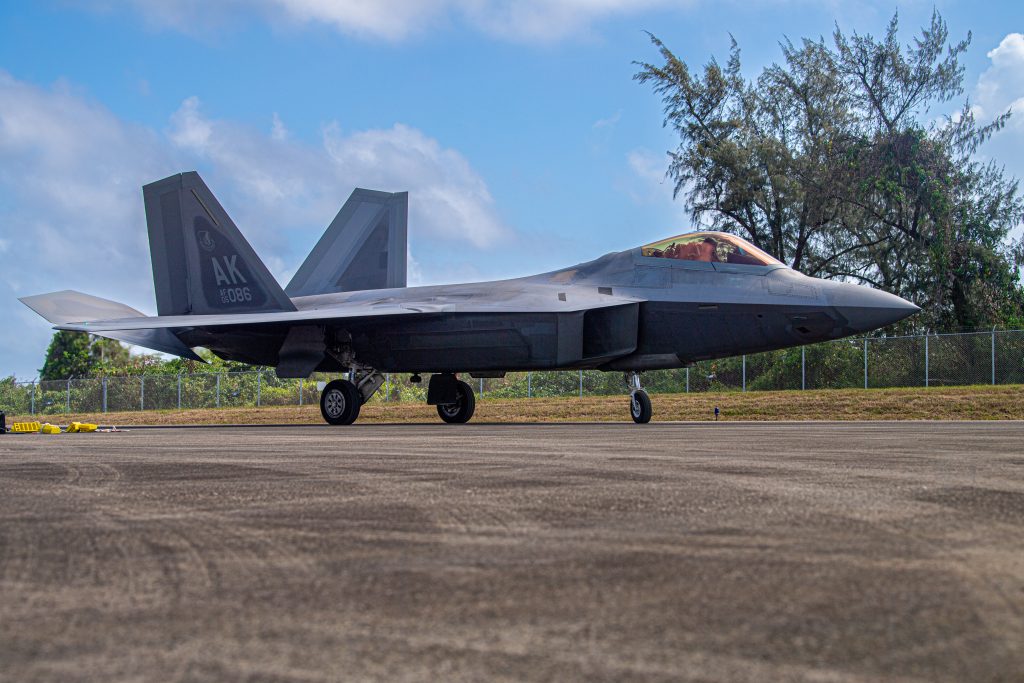The US Air Force (USAF) recently concluded a seven-day exercise operating its F-22A Raptors and aircraft from austere, basic airfields in the western Pacific’s Guam and Mariana Islands.
This was part of its Agile Combat Employment (ACE) concept, where aircraft operate from dispersed locations that may not necessarily have the complete supporting infrastructure. The idea is to not concentrate their operations at a single location that may come under attack.
The Swedes base their entire air warfare doctrine on the ACE by designing and flying the Saab Gripen from small roads and highways around forests and mountains. The Indian Air Force (IAF) too has flown its Mirage-2000 fighters from highways and expressways in north India and the National Capital Region (NCR).
The American effort is greater in magnitude and scale since its military is operating from outside its continental mainland to neutralize threats from adversaries like China and Russia. This entails a series of intertwined logistical and diplomatic challenges.
Fan Out & Hit China
The idea is to spread out, get close, and fight China inside its anti-access/area-denial (A2/AD) bubble. However, risks remain with basing, logistical issues, and the current obstacles faced by the US defense industrial base in mass manufacturing ammunition and ordnance for conventional wars with peer rivals.
The drill, called Agile Reaper, took place for the second time after its inaugural edition last year and saw the participation of 800 Airmen and 29 aircraft across five different locations in mid-April. The exercise focused on “training on the Agile Combat Employment concept that leaders say will define the service in the years to come,” said an April 29 report on Air and Space Forces (ASF).
The 3rd Air Expeditionary Wing from Joint Base Elmendorf-Richardson (JBER) Alaska, “conducted simulated combat situations and tested agility in deploying combat air power across the expansive Indo-Pacific region.”

“The goal is to develop resilient warfighters who are confident in their ability to execute using mission-type orders, generate airlift sorties in a contested environment with limited resources, and grow together as a diverse team while gaining familiarity with other career fields,” Lt. Col. Logan Sutton, 535th Airlift Squadron commander, said in a release.
The statement said ACE is “designed to ensure the 11th Air Force can operate as a cohesive team, focusing on the skills needed to optimize wartime operational mission generation. Agile Reaper allowed the 15th Wing to exercise transitioning from supporting regular operations to an expeditionary status.”
‘Hub & Spoke Model’
The term “expeditionary” implies USAF elements operating out of their home bases (“hubs”) that host the units and formations and fanning and converging across the smaller airfields (“spokes”). The latter is inside the theater’s operational area and within the adversary’s (in this case China’s) weapons engagement zone.
In theory, combined with the US Marine Corps (USMC) Force Design 2030, Expeditionary Advanced Base of Operations (EABO), and the US Navy’s Distributed Maritime Operations (DMO), ACE is expected to present targetting dilemmas to Chinese long-range fires of it’s land-attack ballistic and cruise missiles.
With ACE in the picture, the US Navy and the USAF can be expected to conduct strategically coordinated operations to hit the People’s Liberation Army Navy (PLAN) and the People’s Liberation Army Air Force (PLAAF).
Even the US Marine Corps (USMC) air wing is pursuing its version of ACE centered around its Vertical Take-Off Landing (VTOL)-capable ‘B’ variant of the F-35 (F-35B), with its Forward Operational and Refuelling Point (FARP) concept.
The exercise used a ‘hub-and-spoke’ model: Andersen Air Force Base, Guam, and Hickam Field Base in Hawaii served as the hubs, while Saipan, Tinian of the Northern Mariana Islands, the Japanese island of Iwo To, and Guam’s Andersen’s AFB’s Northwest Field served as the spokes.
The “main operating base” provides “increased mobility and connection to supporting bases within a region.” Many of the spokes have “limited resources and bare-bones facilities.” “While the Northwest Field is on Guam, it is separated from the rest of the base.”
America’s ‘Best’ Fighter
F-22s from Joint Base Elmendorf-Richardson (JBER) Alaska and Joint Base Pearl Harbor-Hickam (JBPHH) Hawaii, flew across the Pacific for the exercise.
JBER also sent an HC-130 Combat King II for air refueling and a C-12 Huron for transport. KC-46 and KC-135 tankers came from McConnell AFB, Kansas, and Eielson AFB, Alaska respectively.
Travis AFB in California dispatched its C-5 Galaxy, and Yokota AFB in Japan, contributed a C-130 Hercules to ferry servicemen and cargo back and forth between Guam.
- The author can be reached at satamp@gmail.com
- Follow EurAsian Times on Google News